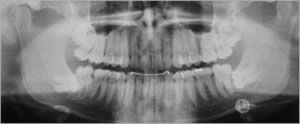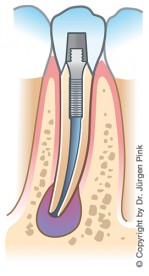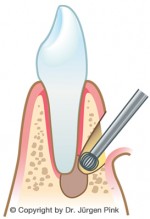The field of dental surgery includes all surgical interventions in the mouth and jaw area that can be performed on an outpatient basis. In our practice, we offer the following surgical procedures within the oral cavity:

Wisdom teeth often have no place in the jawbone and therefore cannot break through into the oral cavity. In this case we speak of a retained tooth. As a result, inflammation, cysts and pain can occur. Wisdom teeth are usually removed in pairs under local anesthesia. If you wish to have all wisdom teeth removed at once, you can have this procedure performed under general anesthesia. Depending on the initial situation, this will be decided in an individual, personal consultation with you.

Indikation bei Rezessio-nsdeckung
A recession results from an inflammation-free regression of the gums, e.g. due to a wrong tooth brushing technique. This exposes the necks of the teeth or creates unsightly gaps between the teeth.
Recession cover serves to restore natural aesthetics. Previously exposed tooth necks that were sensitive (e.g. to heat/cold or sweet/sour) are protected by new gums, root caries can be prevented.
Depending on the situation, these are the following options for recession coverage:
- membrane technology
- connective tissue graft
- gum transplant

Inflammation of the root
Root tip resection is the removal (resection) of a root tip (apex) of a tooth from the outside.
In the case of root-treated or nerve-dead teeth, inflammatory processes can occur at the tooth roots with participation of the jawbone. If the clinical and radiographic examination shows that the affected tooth can be preserved, despite this root tip inflammation, a so-called root tip resection (or periradicular surgery) is performed.
The aim of this procedure is to hermetically seal the root tip in order to interrupt the supply of bacteria from the root canal into the jawbone. The root inflammation is then completely healed by filling the bone cavity with regenerating bone.
Signs of root tip resection
This surgical procedure may be indicated in different ways:
- Root canal treatment has been performed correctly, but complications occur
- The root canal filling was leaking and bacteria got into the root tip
- A conservative therapy does not promise a successful treatment, if
- the inflammation has already spread to the bone
- a cyst close to the root is present
- special anatomical conditions are present (e.g. root curvature)
Apicoectomy: the procedure

Apicoectomy: the procedure
After a detailed examination and an individual consultation, the procedure is performed under local anesthesia (lidocaine injection). The oral cavity is then disinfected and kept sterile. The actual procedure of the root tip resection takes place in several stages:
- Dr. Pink carefully makes an incision in the gums and exposes the tooth bone over a small area.
- The root of the tooth is then exposed in a small hole and the inflamed part of the root and the damaged tissue are removed.
- The end of the root tip is sealed with cement.
- The wound is sterilely treated and sewn.
Prognosis and aftercare
In some cases it may happen that a cyst forms again at the root apex, because the inflammation has not healed yet. Also for this reason a regular check-up at the dentist every 6 months is of great importance. Dr. Pink can use X-rays to follow the healing process and the bone formation and, if necessary, take further steps.
Immediately after the procedure, the affected area should be cooled from the outside 5-6 times a day for 1-2 minutes. In addition, the oral cavity should be cleaned with a tooth rinse (e.g. Chlorhexamed) after each meal and tooth brushing. This will keep the wound clean and sterile. In case of pain, medication can be taken, please talk to your doctor.
In the first days after the operation you should generally take it easy on yourself, do no perform strenuous work or sport, as this can lead to unwanted bleeding. You should also avoid alcohol, nicotine and spicy food.
We have dedicated a separate chapter to this frequent and serious treatment. You will find detailed information about the origin, symptoms and treatment under parodontology.




